
{*■
*
28. Var. rubicans, Ros.
Roiigette. Putamen small. Yield annual and large.
29. Yar. alba, Ros.
Olive blanche, Blancane, Vierge. This with many others
omitted on this occasion is an inferior variety.
30. Var. Caillet Rouge.
Figanier. Small tree. Fruit large, red. Oil good and produced
in quantity.
31. Var. Caillet Blanche.
F ru it almost white, produced annually and copiously, yielding
a rather superior oil.
32. Var. Raymet.
F ru it large, reddish. Oil copious and fine. This variety
prefers fiat country.
33. Var. Cotignac. ,
Pardigniere. F ru it middle-sized, blunt. Oil obtamed lu
quantity and of excellent quality. Tbis wants much pruning.
34. Var. Bermillaon.
Vermilion. Yields also table-oil and resists cold well.
Many other apparently desirable varieties occur, among which
the Italian Oliva d’ogni mese may be mentioned, _ which
ripens fruits several times in tbe year, and furnishes a
pleasant oil and also berries for preserves.
Onobrychis sativa, Lamarck.*
The Saintfoin, or Esparsette, or Cocks-bead Plant, bouth
and Middle Europe, Middle Asia. A deep-rooting perennial
fodder-berb, fond of marly soil, and living in dry locahties.
I t is thus well adapted also for the limestone formation of
the lower Murray Biver. I t prepares dry calcareous soil
also for cereal culture. Stagnant underground humidity is
fatal to this plant. I t prospers still where Red Clover and
Lucerne no longer succeed. Sheep cannot so well be tmmed
out on young Saintfoin fields as cattle. The bay is superior
even to th a t of Lucerne and Clover. The plant will hold
out from five to seven years (Langethal).
Ophelia Chirata, Grisebach. {Agathotes Chirata, D. Bon).
Widely dispersed over the higher monntain-regions of India.
A pereimial herb, considered as one of tbe best of tonics; it
possesses also febrifugal and antarthritic properties. Its administration
in the form of an infusion, prepared with cold
water, is the best. Besides O. elegans (Wight) some of the
other Upper Indian, Cbinese and Japanese species deserve
probably equal attention. Hanbury and Fltickiger mention
as Chiratas or Cbirettas of Indian bazaars; O. angustifolia
(D. Don), 0 . densiflora (Grisebach), O. elegans (Wight) and
0. multiflora (Dalzell), besides species of Exacum and Andro-
graphis. All come from the cooler uplands.
Opuntia coccinellifera. Miller.
Mexico and West India. The Cochineal Cactus. On this
and 0. Tuna, 0. Hernandezii and perhaps a few others
subsists the Coccus, which ofiers the costly Cochineal dye.
Three gatherings can be effected in tbe year. About 1200
tons used to be imported annually into Britain alone, and a
good deal also to other countries, valued a t about £400 for
the ton. The precious Carmin-pigment is prepared from
Cochineal.
Opuntia Dillenii, Candolle.
Central America. A Tuna-like Cactus, serving for uninflammable
hedges, and perhaps also for the rearing of the
Coccus Cacti. I t is particularly eligible for barren land.
Opuntia elatior, Miller.
Central America. A hedge-plant with formidable thorns.
Opuntia Ficus Indica, Miller.
Central America, north as far as Florida. Serves for hedges.
Pulp of fruit edible.
Opuntia Hernandezii, Candolle.
Mexico. Afibrds also food for the Coccus Cacti.
Opuntia Missouriensis, Candolle.
From Nebraska to New Mexico. Mr. Meehan found this
Cactus covered with the Cochineal Coccus, and points to the
fact that this insect will live through the intense cold, which
characterises the rocky mountains of the Colorado regions.
Opuntia Railnesquii, Engelmann.
North America. The most northern of all species, extending
to Lake Michigan.
Opuntia spinosissima. Miller.
Mexico and West India. Stem columnar with pendant
branches. Also a good hedge-plant.
Opuntia Tuna, Miller.
West India, Ecuador, New Granada, Mexico. Irrespective
of its value as the principal Cochineal-plant, this Cactus is
also of use for hedges. I t will attain a height of twenty
feet. The pulp of the fruit is edible. With the other
species hardy at least in our lowlands.
Opuntia vulgaris. Miller.
Central America, northward to Georgia, southward to Peru.
Adapted for hedges and like the rest not inflammable, thus particularly
valuable along railway lines. The fruit almost
smooth, also eatable. A dye can also be prepared from its
f I